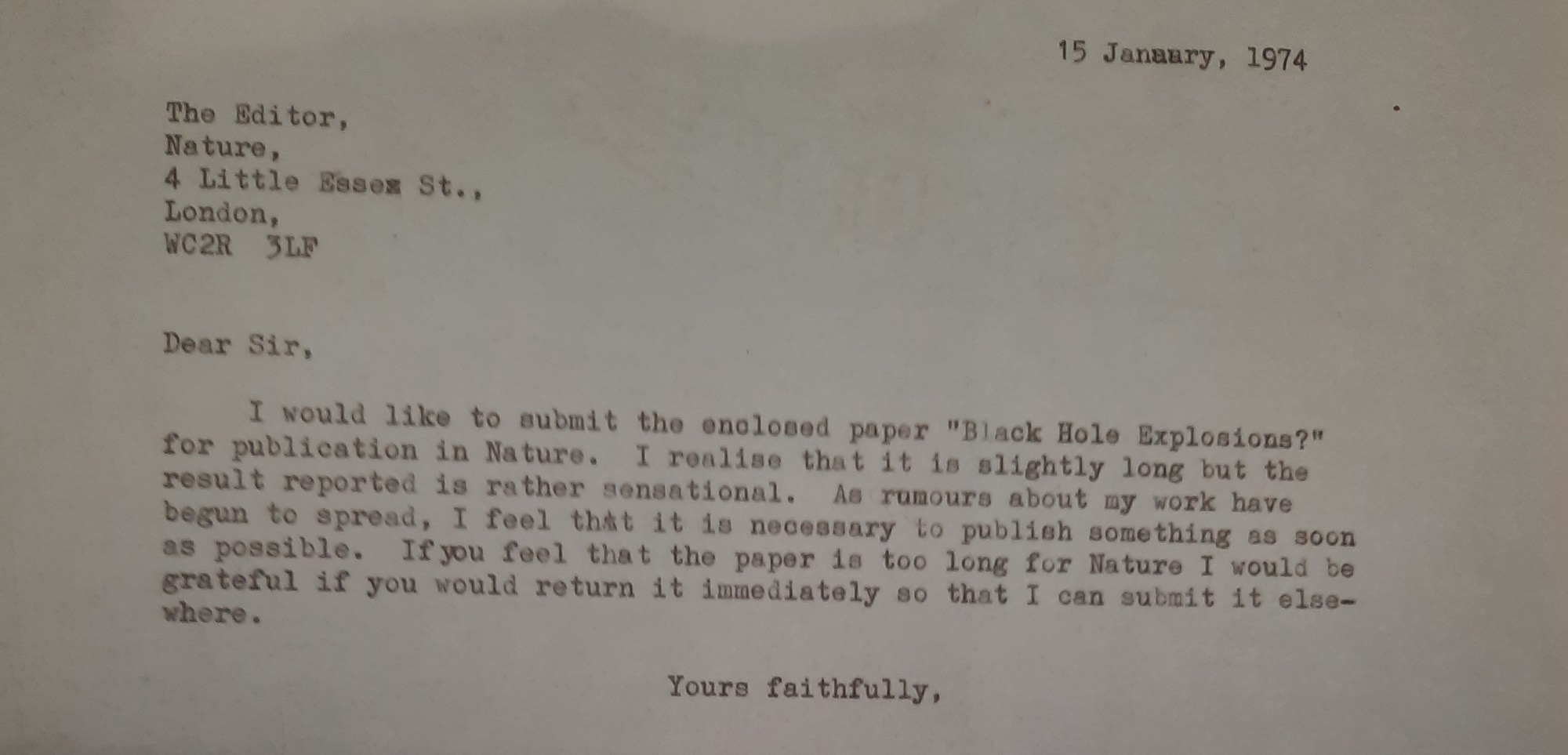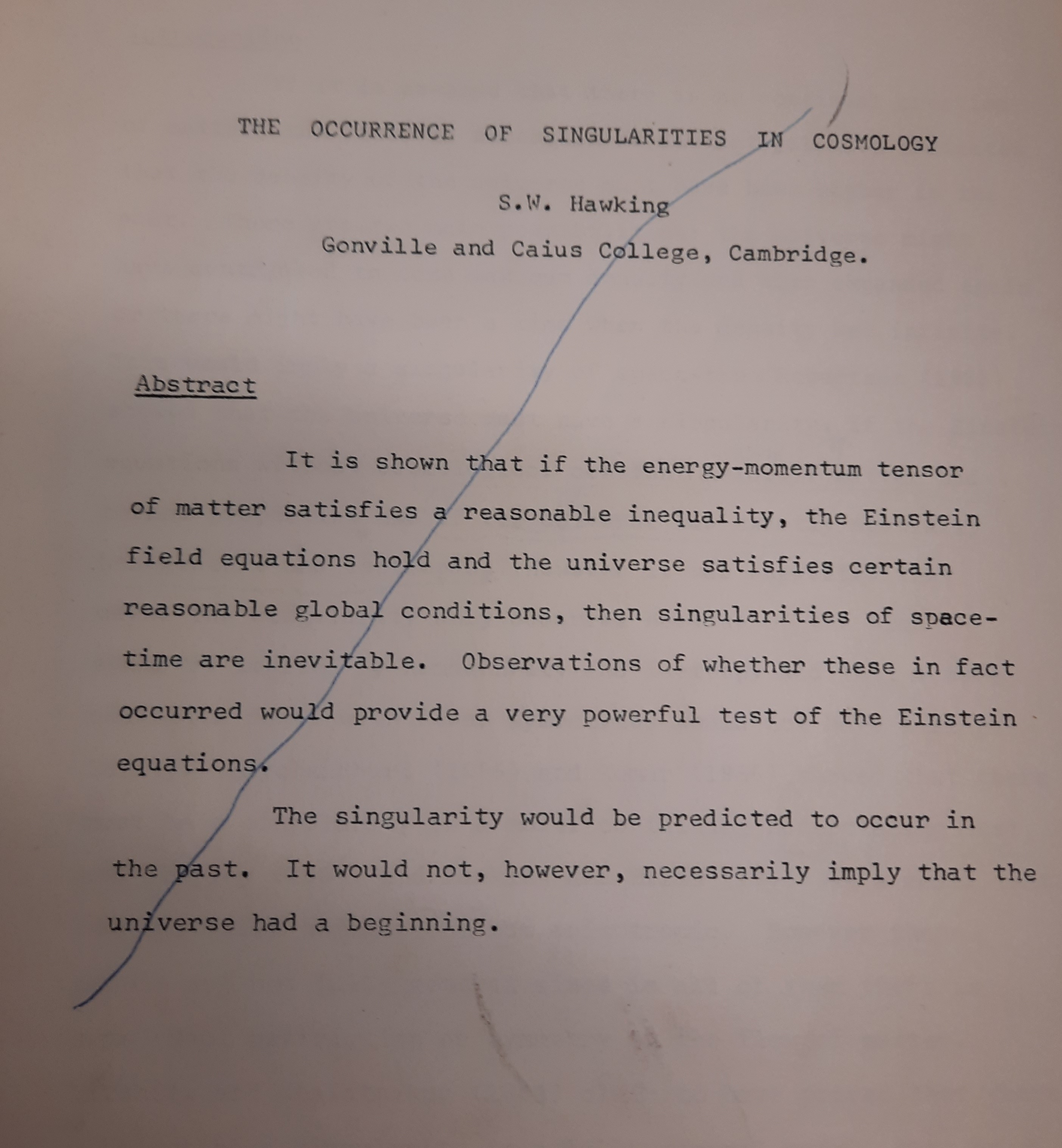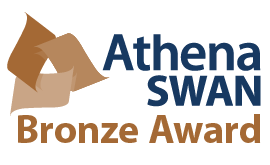
In a major acquisition by the nation, Cambridge University Library will host Stephen Hawking’s personal archive, and the contents of his office will be preserved by the Science Museum, with highlights going on public view early next year.
Stephen Hawking was one of the best-known scientists of his generation, who inspired people far beyond the field of his research. While delivering spectacular advances in the theory of gravity and cosmology, he also came to symbolise the triumph of hope over adversity — and demonstrated that a deep interest in fundamental science doesn’t preclude a sense of humour. Apart from a vast volume of scientific output, this resulted in numerous popular science books, and many TV appearances.
Earlier this year it was announced that elements of both aspects of Professor Hawking’s life — the scientific and the personal — will be preserved for future generations to explore.
The Hawking archive
"To see the original and draft versions of these papers is thrilling for scientists and historians of science alike, and we hope it will inspire the next generation to reflect on Stephen’s contributions and to follow in his footsteps"Professor Paul Shellard
Stephen Hawking’s personal archive, which includes around 10,000 pages of letters, scientific papers and scripts of his media appearances, will be preserved by the Cambridge University Library and made accessible to the public.
The Hawking archive is greatly diverse. Alongside drafts of scientific papers and correspondence with collaborators, there are film and TV scripts such as the Oscar-winning The Theory of Everything and Hawking’s appearance on The Simpsons, and correspondence on disabled access and rights.
One of the most moving items dates from 1964. It is a glowing letter from Dennis Sciama, Hawking’s PhD supervisor and one of the founders of modern cosmology, to the 22-year-old budding researcher's father, Frank. The letter concludes: 'It is a real pleasure for me to supervise him – indeed I am now at the stage of learning from him.'
Professor Paul Shellard, Director of the Centre for Theoretical Cosmology and a former PhD student of Hawking, explained the significance of the archive:
"Stephen has a profound legacy and a huge influence on cosmology and gravitation, particularly his breakthrough discovery that black holes radiate. This brought together for the first time the two great revolutions of twentieth-century physics: quantum mechanics on microscopic scales and general relativity on the huge scales that govern the evolution of the universe."

Submission letter to 'Nature' for Hawking's paper on black hole radiation, 1974
Sharing science widely
"It is wonderful that these landmark papers which were so influential will be accessible to everyone and housed here in Cambridge, Stephen’s academic home for over 50 years," said Shellard. "To see the original and draft versions of these papers is thrilling for scientists and historians of science alike, and we hope it will inspire the next generation to reflect on Stephen’s contributions and to follow in his footsteps – how through his curiosity and his determination in the face of adversity, he was able to see so much further than others."
Dr Jessica Gardner, University Librarian, emphasised the Library’s commitment to making the archive available to the widest possible audience in perpetuity. The acquisition means that three of the most important scientific archives of all time – those of Isaac Newton, Charles Darwin and Stephen Hawking – are now housed under one roof in Cambridge:
"One of the reasons I’m so pleased the archive is here is that it’s what Professor Hawking wanted to happen", said Gardner. "And part of that was joining the pantheon of scientists and their great discoveries which are represented in the archive of Cambridge University Library. Cambridge is a place where great discoveries that change the world happen, and so it is wonderful to complete the trinity of Newton, Darwin and Hawking here at Cambridge University Library, and to make these collections open and available for research and study to students of all ages across the world."
"As a family we’re absolutely delighted that the archive is going to be looked after so well,” said Hawking’s son Tim. "Our father would be really pleased. It was really important during his lifetime that science be opened up to the widest possible number of people."

Draft paper by Hawking, 1966
Bets and blackboards
The entire contents of Hawking's office in the Department of Applied Mathematics and Theoretical Physics (DAMTP) have been given to the nation for display in the Science Museum. Selected items from the office will go on public display in early 2022, with the rest being made available in the Science Museum Group’s online collection later in the same year. This provides a rare opportunity to share the day-to-day surroundings of Hawking's working life at DAMTP, and also gives an insight into the personal and human side of science.
The items from Hawking’s office include six of his wheelchairs, demonstrating the immense advances in the technology that supported his life with motor neurone disease. But there are also items illustrating the playful side of Hawking's character: copies of bets he made with fellow scientists adorned with Hawking’s thumb prints, for example, and a coxing blazer he wore as an undergraduate and refused to have washed because he was thrown into the river wearing it. There are also mementos from Hawking’s appearances on Star Trek and The Simpsons, such as a personalised Simpson’s letterman jacket. And of course there are the blackboards that played host to many of Hawking’s pioneering ideas.
"It’s an amazing collection of all the objects, and the paperwork, and the books, and all the artefacts that were in his office in Cambridge," said Hawking’s daughter Lucy. "So it’s an opportunity to experience his working environment as it was."
Standing on the shoulders of giants
Hawking's scientific legacy will also continue into the future through the University's Stephen Hawking Programme. Building on Hawking’s achievements in the field, the Programme will support trailblazing work to push forward the boundaries of our understanding of the Universe, complementing the work of the Stephen Hawking Centre for Theoretical Cosmology. Alongside a Hawking Professorship, the Programme will support young researchers and students as Fellows and Scholars, giving them the independence and intellectual freedom to explore ambitious, pioneering research. To continue to inspire future generations, the Programme will also involve extensive outreach activity, reflecting Stephen Hawking's outstanding and extraordinary achievements in the public communication of science.
The acquisition for the nation of Stephen Hawking’s archive and office contents is on a historic scale, reflecting his impact on both cosmology and wider science engagement. It’s a fitting tribute to Hawking’s legacy as one of the scientific giants on whose shoulders future generations will stand, inspiring us all to look up at the stars and see further.
Part of this article is based on a news article from the Centre for Theoretical Cosmology. To find out more about supporting the Stephen Hawking Programme, please see here.
Image at top of page: Andre Pattenden

